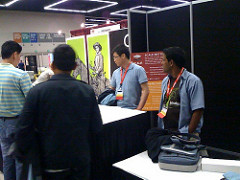There have been several methods to deploy an Ruby on Rails application. Until recently, the most popular is to run Apache and proxy balance to multiple Mongrel instances that are running simultaneously.
Passenger, developed by Phusion, is the new kid entering the Rails deployment market. Everyone has been using the Apache PHP module for years and deploying a PHP applications is a snap. This has not been possible with Rails until Passenger. It is extremely easy, and you can still use Capistrano to automate deployment. I will show you how I get it to work on Ubuntu.
sudo gem install passenger passenger-install-apache2-module Update: Phusion just released Passenger 2.0 RC 1. You can download this version and do gem install passenger-1.9.0.gem instead. But I had an error compiling it on Mac OS X Leopard. hongli pointed me to use the version from GitHub that has the fix and it works like a charm. Thanks Phusion guys.
To get it from GitHub:
git clone git://github.com/FooBarWidget/passenger.git I created a separate /etc/apache2/mods-available/passenger.load and it contains the following:
For 1.0.5:
LoadModule passenger_module /usr/local/lib/ruby/gems/1.8/gems/passenger-1.0.5/ext/apache2/mod_passenger.so RailsSpawnServer /usr/local/lib/ruby/gems/1.8/gems/passenger-1.0.5/bin/passenger-spawn-server RailsRuby /usr/local/bin/ruby For the GitHub version (Of course the path will look different depending on where your git clone is):
LoadModule passenger_module /home/rlaw/downloads/passenger/ext/apache2/mod_passenger.so PassengerRoot /home/rlaw/downloads/passenger PassengerRuby /usr/local/bin/ruby I then tell Apache to load the Passenger module:
a2enmod passenger Now, I create a virtual host configuration for one of my Rails app in /etc/apache2/sites-available/myapp:
<VirtualHost *:80> ServerAdmin webmaster@myapp.com ServerName myapp.com DocumentRoot /home/deploy/apps/myapp/current/public <Directory /home/deploy/apps/myapp/current/public> Options FollowSymLinks AllowOverride None Order allow,deny Allow from all </Directory> LogLevel warn ErrorLog /var/log/apache2/myapp/error.log CustomLog /var/log/apache2/myapp/access.log combined </VirtualHost> I then restart Apache:
sudo /etc/init.d/apache2 reload When you need to restart your application because you have changed some code that Rails does not reload in production, just do:
touch /home/deploy/apps/myapp/current/tmp/restart.txt I have not tried their Ruby Enterprise Edition yet. They claim substantial memory and speed improvement at RailsConf 2008, so it will be interesting to see how that develops.








